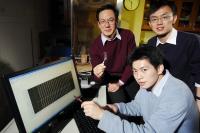A research project, supported by the U.S. Department of Energy, the National Science Foundation, and the Defense Advanced Research Projects Agency, has developed nanometer-based sensing devices that can be used for the detection of UV light or determining the pH value of liquids.
 Researchers examine nanowire array images
Researchers examine nanowire array images
These devices utilize the electric current generated due to the conversion of mechanical energy.
These devices incorporate up to 20,000 nanowires made of zinc oxide in every nanogenerator. The devices generate a maximum of 1.2 V output are made using a chemical process that facilitates less-expensive manufacturing using flexible substrates. Tests conducted on about 1000 nanogenerators that did not have moving mechanical components indicated that they could function without decrease in generated capacity over time.
Nanoscale generators based on the piezoelectric effect are under development by Zhong Lin Wang, the School of Materials Science and Engineering¡¦s Regent professor at the Georgia Institute of Technology, and his research team during the last five years. The piezoelectric effect results in the production of electric charges when zinc oxide wires undergo strain by simply flexing them, and the total current produced by a combination of such wires can power small gadgets. Presently the researchers are working on increasing the voltage and current produced and also render these devices sturdier.
A new nanowire configuration has been reported in a paper by Wang and his team. They have fixed two ends of miniaturized structures into a polymer substrate.
Compressing the wires inside a flexible enclosure of nanogenerator resulted in current generation, without the need to use a metallic electrode that was used in earlier devices. The nanogenerators can be utilized for a wide range of applications since they are enclosed completely.
Wang explained that the research team is now capable of growing these wires on flexible and foldable substrates and the process can be carried out at substrate temperatures that are below 100„aC. He revealed that this process will facilitate reduced fabrication cost as well as growth on any substrate.
A multiple-step method is used to make nanogenerators. The method involves fabricating electrodes for providing Shottky and ohmic contacts to nanowires. It is possible to grow nanogenerator arrays laterally as well as vertically. The crystalline growth has to be aligned. In addition, the charging and discharge cycles have to be synchronized to ensure the generation of maximum voltage and current.
The amount of electric current generated at the output of the nanogenerators depends on the applied strain. Wang explained that an output of 1.2 V can be generated when the rate of strain is less than 2% a second and this output is then matched to the external load.
By incorporating 700 rows of nanowires made of zinc oxide in lateral nanoganerators, it is possible to generate a peak voltage of 1.26 volts with 0.19% strain. Vertically integrating three zinc oxide-based arrays of nanowires in a separate nanogenerator resulted in the generation of a maximum of 2.7 mW/cm3 of power density. Wang and his research team have so far created two zinc oxide nanowires with miniature sensors.
The researchers were also able to determine the acidity of liquids by using the pH sensor for measuring the changes in voltage amplitude across the device when it is exposed to various fluids. An UV nanosensor also uses similar changes in voltages for detecting incident UV light.
It is possible to develop miniature sensing devices that function without batteries by using nanoscale sensors and generators. These devices will be powered by environment-harvested mechanical energy. The movement of clothing, pressure from hiker¡¦s shoes, flag flapping in the wind, sonic waves, mechanical vibration, and tide motion are some forms of the energy available in the environment for harvesting.